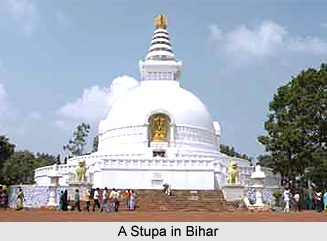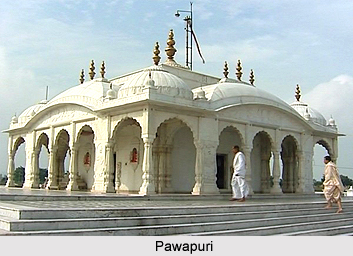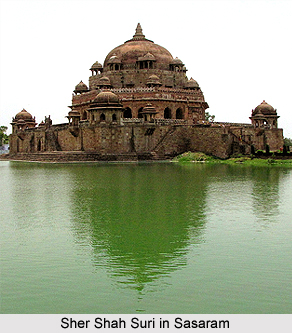 Pilgrimage tourism in Bihar is well known for its pilgrimage centers comprised of Hindu, Muslims and Buddhist monasteries, temples and mosques. As far as pilgrimage centers are concerned most popular of these is Gaya. This place is considered a sacred place for worship by the Hindus. Lord Vishnu (Lord Vishnu in Rig Veda) is said to have conferred upon Gaya the power to cleanse one of one`s sins. Devotees flock here to perform ceremonies to clear their dead of the burden of sin they might have carried over to the next world. They take a holy dip in the Phalgu River and lay offerings of pindas (sweets) and ritual rice cakes on the ghats along the river, before entering the Vishnupada Mandir (closed to non-Hindus) built by the Maharani of Indore in Madhya Pradesh in 1787 over the footprint Lord Vishnu is believed to have left on a stone. Within the grounds of the temple stands a banyan tree which is said to be the one under which Lord Buddha spent six years meditating.
Pilgrimage tourism in Bihar is well known for its pilgrimage centers comprised of Hindu, Muslims and Buddhist monasteries, temples and mosques. As far as pilgrimage centers are concerned most popular of these is Gaya. This place is considered a sacred place for worship by the Hindus. Lord Vishnu (Lord Vishnu in Rig Veda) is said to have conferred upon Gaya the power to cleanse one of one`s sins. Devotees flock here to perform ceremonies to clear their dead of the burden of sin they might have carried over to the next world. They take a holy dip in the Phalgu River and lay offerings of pindas (sweets) and ritual rice cakes on the ghats along the river, before entering the Vishnupada Mandir (closed to non-Hindus) built by the Maharani of Indore in Madhya Pradesh in 1787 over the footprint Lord Vishnu is believed to have left on a stone. Within the grounds of the temple stands a banyan tree which is said to be the one under which Lord Buddha spent six years meditating.
Haramandir, a Gurudwara in old Patna, is one of the holiest places for the Sikhs. Guru Govind Singh, the tenth and last Sikh Guru, was born and died here. it was built in the 19th century around the room where the Guru was born and stands at the centre of Patna`s Sikh district. It is a tall building in white marble, housing a museum of the Sikh religion. Apart from this Patna houses some of the most interesting Mughal religious buildings. At Maner, 18 miles away from Patna, are two mausoleums: Choti Dargah, in a small Muslim cemetery, is the grave of Maneri, a Muslim ascetic of the 17th century. Bari Dargah, on the high bank of an artificial pond, was built around 1620 by Ibrahim Khan, Governor of Bihar under Jahangir, as a mausoleum for Shah Daula, his religious preceptor.
At Sasaram there are some large monuments belonging to the era of Sher Shah Suri in North India. The Tomb of Sher Shah built in the 16th century in the middle of a square; a wide tank, and the mausoleums of Hassan Sur Khan, Sher Shah Suri`s father, Alawal Khan, the officer in charge of building the mausoleum and the uncompleted one of Salim Shah, Sher Shah`s son.
 Religious places belonging to the Buddhists are scattered throughout Bihar. Foremost amongst these is the place where Buddha attained enlightenment. It is located in Bodhgaya, 12 km south of Gaya, along the Phalgu River. It was actually King Ashoka who erected a shrine near the Bodhi tree under which Gautama Buddha received enlightenment. This was replaced in the 2nd century by the present Mahabodhi Temple with a 177-ft spire. Under the tree is the Vajrasana, the Diamond Throne, a stone slab marking where the Buddha was sitting when he attained enlightenment.
Religious places belonging to the Buddhists are scattered throughout Bihar. Foremost amongst these is the place where Buddha attained enlightenment. It is located in Bodhgaya, 12 km south of Gaya, along the Phalgu River. It was actually King Ashoka who erected a shrine near the Bodhi tree under which Gautama Buddha received enlightenment. This was replaced in the 2nd century by the present Mahabodhi Temple with a 177-ft spire. Under the tree is the Vajrasana, the Diamond Throne, a stone slab marking where the Buddha was sitting when he attained enlightenment.
A nearby Buddhist temple has been taken over by the Hindus as the Buddha is considered an avatar of Vishnu and it is now managed by a joint Buddhist-Hindu committee. Inside it a one will come across a gilded statue of the Buddha, sitting cross-legged, with his right hand touching the ground. Around the temple are votive stupas.
Excavations in Nalanda have yielded nine levels of occupation, six temples (chaityas) and 11 monasteries {viharas), all built in redbrick. The monasteries are on the eastern side. The main ones are Vihara: 1 founded in the 9th century by King Balaputradeva of Sumatra, and Viharas 4 and 5, built by King Kumar Gupta in the 1st century AD, with later additions by kings Harshavardhana and Devapala. The viharas show remains of student cells, lecture halls, bathrooms, kitchens, libraries, storage rooms and wells.
To the west are the temples. The most imposing is the Sariputra Stupa, built by Ashoka in honour of Ananada, the Buddha`s first disciple, who was born and died at Nalanda. It is a three-level structure, partly covered with stucco figures of Lord Buddha teaching at Bodhgaya, Nalanda, Rajgir, Sarnath and Vaishali, and surrounded by stupas erected to the memory of students who died during their studies, that could then last a whole lifetime.
North of Nalanda, a monument in the shape of a Chinese temple has been built to commemorate the memory of Hsuan Tsang, the Chinese traveler who studied at Nalanda in the 7th century.
Leaving Nalanda for Rajgir, the road passes a small Chinese temple, the Nava Nalanda Mahavira Research Centre on Buddhism and Pali Literature, set up by the Bihar Government, and Wat Thai Nalanda, a small Thai temple of recent construction.
Chanka Ramana in Bodh Gaya is a platform built in the 1st century BC which marks the place where the Buddha walked in meditation. Carved stone lotuses indicate the spots where the lotuses sprung from his feet. South of the temple a statue of the Buddha protected by a cobra stands in the middle of a large lotus pond.
 Buddhist communities from all over Asia have built monasteries in Bodhgaya. Each one is a technology centre and most accept foreign students.
Buddhist communities from all over Asia have built monasteries in Bodhgaya. Each one is a technology centre and most accept foreign students.
On the way back to Patna, Pawapuri, 20 miles (32 km) to the southeast, is a holy place for Jains. It was here that Lord Mahavira attained salvation in 477 BC. A white marble temple, the Jalmandir in the middle of a lotus pond, marks the place where he was cremated. There are five more Jain temples around the pond.
Rajgir, or Rajgriha, the "royal palace" was the capital of the Magadha empire in the 6th century BC. It is a holy place for both Jains and Buddhists. Lord Mahavira taught here for 14 rainy seasons; Muni Suvrata, the 20th Jain Tirthankara, was born here and all of Lord Mahavira`s earliest disciples died here. A monastery built by Mauryan king, Bimbisara, is set in a bamboo park. The First Buddhist Council, six months after the Buddha`s death, was held at Rajgir.
Immediately to the south of Venuvana in Rajgir, at the foot of Vaibhara Hill are Jain and Hindu temples built around 22 hot springs. Public baths have been set up where one can relax in hot emerald-green waters. Further up, past the Pippla Cave and the Jarasandha-ki-Baithak, a monastery built out of large blocks of stone, is the Saptaparni cave where the First Buddhist Council was held. Further south, Manyar Math, a cylindrical stone structure, is a former temple to Maninaga, a serpent demi-god, referred to in the Mahabharata. Turning left the road passes Jivakamhavana, the site of the mango grove presented to the Buddha by Jivaka, Bimbisara` s physician, and reaches Maddakuchchi from where one has to walk to Gridhrakuta Hill, probably the holiest place in Rajgir, where the Buddha delivered most of his sermons. From Maddakuchchi, an aerial ropeway chairlift leads to the top of Ratna Giri, a hill at the top of which Japanese Buddhists have built the Vishwa Shanti Stupa, a huge white structure visible from miles around. Four golden statues, one on each side, represent Buddha` s birth, enlightenment, teachings and death.
Most of the events in the Hindu epic of Ramayana took place in Bihar. As a result a lot of places situated in Bihar, such as, Vaishali, Buxar, Darbhanga District, Munger District, Gaya, Bhojpur District and other cities are worth a visit. Collectively these have been termed by the state tourism as the Ramayana circuit.






